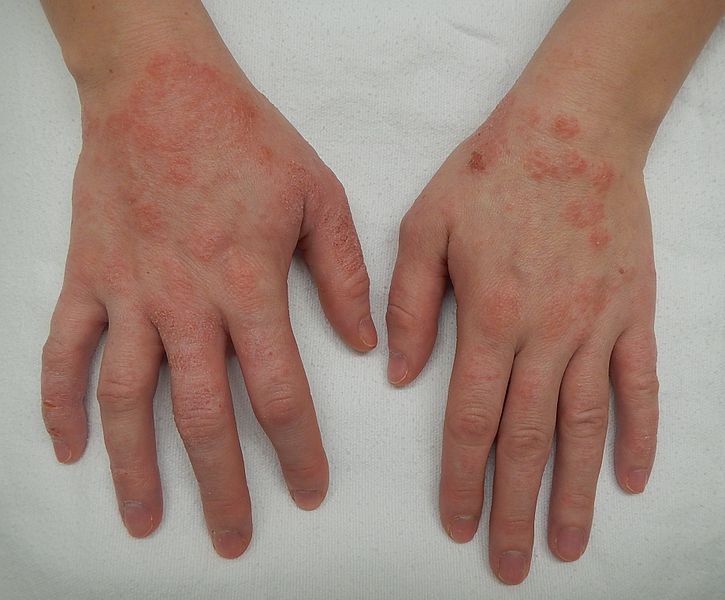Eczema, also known as dermatitis, describes a group of inflammatory skin disease. Various different types of eczema exist, but this article focuses on atopic dermatitis.
Classification
Eczema can either be caused by external stimuli such as:
- Irritant contact dermatitis: Caused by contact with detergents, harsh chemicals, friction, abrasives, dust and even water - contact dermatitis will happen in absolutely anybody as these are known irritants.
- Allergic contact dermatitis: Caused by contact with substances that do not cause a reaction in others as a result of immune sensitisation to a specific allergen e.g. perfumes, rubber, nickel, hair dye etc - patients need patch testing to figure out what exactly they're allergic to.
Alternatively, there are endogenous forms of eczema as well:
- Atopic dermatitis: A chronic condition characterised by itching and is very common in children but can also affect adults. An atopic disease and therefore associated with asthma and allergic rhinitis. This set of notes focuses on atopic dermatitis.
- Seborrheic dermatitis: A condition which mainly affects the scalp, nasolabial folds, eyebrows and eyelids. Results in flaking of the skin, scaly patches, itching and erythema.
- Otitis externa: Dermatitis of the pinna +/- ear canal
- Discoid dermatitis: Discoid, well-defined plaques - also known as nummular dermatitis.
Risk Factors
- Co-existing atopic conditions: Asthma, hayfever, and atopic dermatitis are the three atopic conditions. Having one can increase the risk of having another.
- Family history
Triggers
- Soaps/detergents
- Wool
- Inhaled allergens: Pet dander, pollen
- Pre-menstrual flares of eczema
- Extremes of temperature
- Emotional stress/lack of sleep/teething
- Food-induced: Milk, egg, soy, wheat, peanuts can sometimes cause atopic eczema
Pathophysiology
The underlying mechanism of eczema is thought to be due to a dysfunction of the barrier function of the skin. The precise pathophysiology isn’t fully known, but one proposed theory is that relating to Filaggrin.
The Filaggrin gene codes for a Filaggrin protein found in the stratum corneum and stratum granulosum of the skin and holds skin cells together. It is thought that a mutation occurs in the Filaggrin gene resulting in less production of these binding proteins, resulting in a haphazard arrangement of skin cells which results in loss of water, skin dehydration, and therefore dry skin.
Clinical Features
Patients can have acute episodes or flare-ups of their eczema, or they may have chronic eczema.
- Itching
- Dry skin (xerosis)
- Scaling of the skin
- Lichenification which is a thickening of the skin, particularly in chronic eczema. Occurs due to chronic scratching/rubbing
- Excoriation marks (scratch marks)
- Keratosis pilaris: This occurs when there is hyperkeratosis of the follicles, resulting in small bumps on the skin which can feel rough
- Hyper or hypopigmentation of the skin
- Acute eczema can be associated with vesicles and crusting of the skin
- Rash may affect extensor surfaces more (fronts of knees, elbows, ankles, wrists etc) in infants: This is because they haven't started walking yet and they're mainly crawling and those are the areas that get more irritated.
- Rash may be prominent in the flexures e.g. behind the knees or in the elbows in children and adults: This usually starts around the time walking starts
James Heilman, MD, CC BY-SA 4.0 , via Wikimedia Commons
Dermatitis Affecting the Hands
Severity Assessment
- Mild: Infrequent itching and dry skin, +/- erythema
- Moderate: Frequent itching, dry skin, erythema +/- excoriations/lichenification
- Severe: Constant itching, widespread dry skin, erythema +/- excoriations/lichenification/bleeding/oozing/cracking
Differential Diagnosis
- Psoriasis: Will present classically with plaques which have silver scales
- Contact dermatitis: Looks like eczema, but will relate to an allergen which the patient is being directly exposed to
- Scabies: Burrows between fingers – consider this if other members of the household have itching as well
- Seborrhoeic dermatitis: Tends to affect eyebrows, scalp, and nasolabial folds. Presents with greasy red scales.
Management
Topical therapy is the mainstay of treatment.
- Emollients/Moisturisers: Patients may need to apply this several times a day. They work to reduce dryness of the skin by aiding the barrier function and maintain skin moisture. The thicker the better, but thick ointments aren’t always tolerated.
- Creams and ointments: These are left on the skin
- Thin Creams: Aveeno, Epaderm, E45
- Thick Ointments: Texture can be like petroleum jelly – Hydromol, Diprobase, Epaderm ointment
- Soap or bath oil substitutes: Some emollients can be used as a substitute for soap or bath oils
- Applied 3-4 times a day
- Topical corticosteroid therapy: Usually starting with once daily application. NICE recommend aiming to use them for a maximum of 5 days, whilst treatment should continue for 48 hours after a flare has been controlled.
- You can get mild, moderate, and potent steroids and the strength of the steroid should usually match the severity of the eczema.
- Mild: Hydrocortisone 1%
- Moderate: Betamethasone valerate 0.025%/Clobetasone Butyrate 0.05%
- Potent: Betamethasone valerate 0.1%: Delicate areas e.g. face/periocular region should be avoided
- Steroids are avoided long-term (usually a maximum of 5 days) as they come with a lot of side effects:
- Transient burning/stinging
- Permanent striae
- Thinning of skin
- Acne vulgaris
- Excessive hair growth
- Topical calcineurin inhibitors: These can be considered for a short-term treatment for patients whose eczema has not been controlled by corticosteroids. They are topical immunosuppressants.
- Antihistamines: These can be used for their sedating effects which can be useful for patients whose itching is waking them at night
- Dressings: Dressing can be useful for prolonging the retention of moisturisers as well as creating a physical barrier and thus reducing itching.
- Dry wrapping
- Medicated bandages
- Wet Wraps
Complications
Eczema herpeticum is a serious complication of eczema which warrants immediate referral to a hospital.
References
https://www.ncbi.nlm.nih.gov/books/NBK538209/
https://midessexccg.nhs.uk/medicines-optimisation/clinical-pathways-and-medication-guidelines/chapter-13-skin-3/3101-atopic-eczema-prescribing-guidleines-january-2019/file
https://www.bad.org.uk/shared/get-file.ashx?id=69&itemtype=document
https://www.sign.ac.uk/assets/sign125.pdf
https://cks.nice.org.uk/topics/eczema-atopic/diagnosis/diagnosis/
https://www.ncbi.nlm.nih.gov/pmc/articles/PMC4004110/
